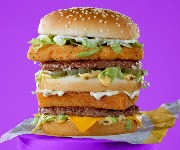Restaurants criticised for salt content of children's meals

Family-friendly eateries slammed for “dangerously” salty children’s options.
A new study from Consensus Action on Salt & Health (CASH) has shown that over a quarter of meals served by supposedly ‘family friendly’ eateries contain more than 2g of salt.
And 2g of salt is the recommended maximum daily intake for children aged between one and three years.
Too much salt in a person’s diet can lead to high blood pressure, increasing the risk of strokes and damage to the circulatory system, including heart failure. CASH says that the levels of salt found in some of the meals was “dangerously high”.
A threat to children’s health
To put the meals with the highest salt content into context, a 32.5g bag of Walker’s crisps contains 0.5g of salt, which is quite a lot of salt for a child to eat in one serving. The worst meals contained more than eight times that much salt.
You probably wouldn't let your kids sit and crunch their way through four packets of crisps, but you understandably may not realise that they’re consuming the equivalent amount of salt in a single sitting when you go for a meal out.
Maximum Recommended Salt Intakes
|
Age |
Maximum salt intake (per day) |
|
0-6 months |
<1g |
|
6-12 months |
1g |
|
1-3 years |
2g |
|
4-6 years |
3g |
|
7-10 years |
5g |
|
11+ years |
6g |
Source: actiononsalt.co.uk
The research singled out Burger King, Hungry Horse and Loch Fyne Seafood and Grill as being particularly bad. Each of these had children’s meals on the menu which contained 4g of salt or more, which would be a lot of salt for an adult to eat at once, let alone a child.
While ordering a vegetarian option might seem like a healthy alternative to beef, a kid’s veggie bean burger with small fries at Burger King contains a whopping 4.6g of salt per serving, which is over twice the amount of salt found in their kid’s hamburger meal – which still isn’t impressive with 2.2g of salt.
If a three-year-old child consumed 2g of salt during other days of the month but ate the above veggie bean burger meal just once a month, they would consume around an extra 31g of salt per year – adding the equivalent of around 15 days’ worth of allowances to their overall intake.
Less salt please!
While Hungry Horse’s large ham with mash and beans was singled out for having 4.2g of salt per serving, its large pork sausages with potatoes and peas contained just 1.1g of salt. That’s still over half the daily limit, but much, much better than the former.
So it’s completely possible for restaurants to serve up children’s meals that contain far less salt, but there doesn’t seem to be any urgency among most of them to do take action on this matter.
Only five of the 23 companies investigated by the survey have made a pledge to reduce salt in their meals by signing up to targets from the Department of Health. Sonia Pombo, a nutritionist at CASH, says that “it’s a scandal that very few restaurants are taking salt reduction seriously.”
Apparently, we eat on average 8.1g of salt per day in the UK, a habit which could cause long-term health problems for us as a country and put further strain on already stretched NHS resources.
Furthermore, the high amounts of salt in meals specifically aimed at children could lead them into “‘salt addiction’” says Graham MacGregor, Professor of Cardiovascular Medicine at Queen Mary University of London and Chairman of CASH.
“Evidence suggests dietary habits in childhood can influence eating patterns later in life,” he explains. "Salt should therefore not be given to children.”
The Department of Health estimates that reducing salt intakes by just 1g a day would save 4,147 preventable deaths and £288 million in NHS spending every year.
You might also like:
Most Recent
Comments
Be the first to comment
Do you want to comment on this article? You need to be signed in for this feature








